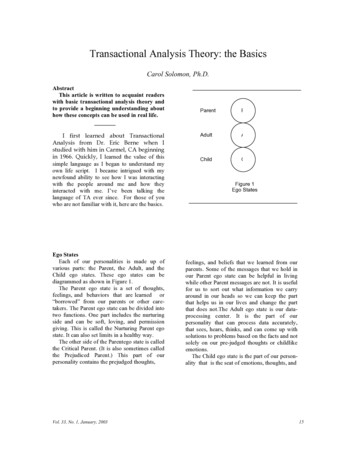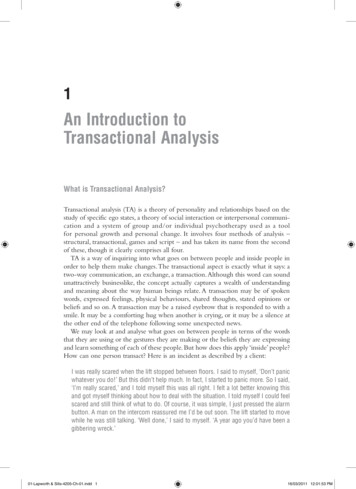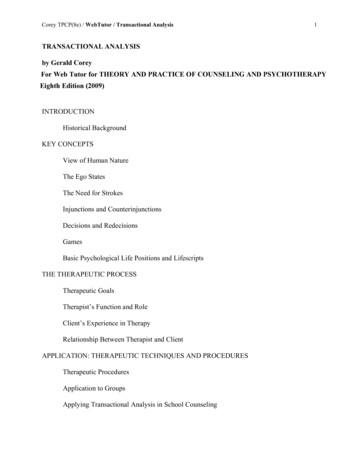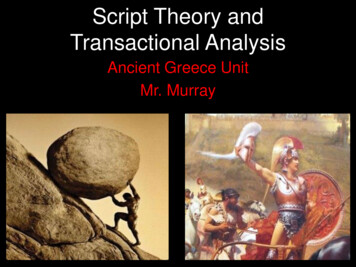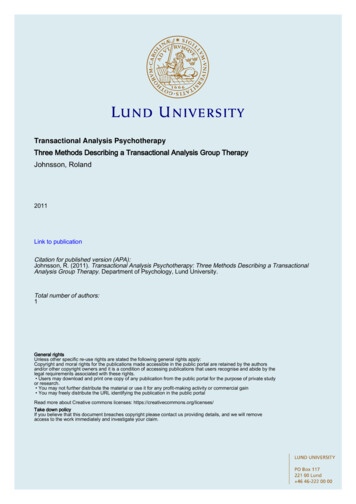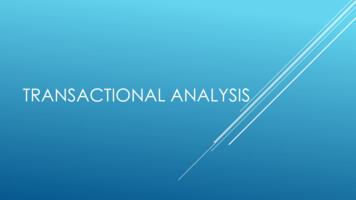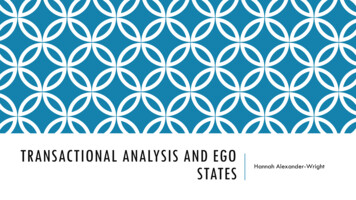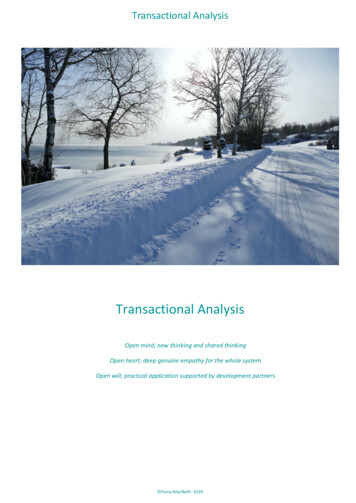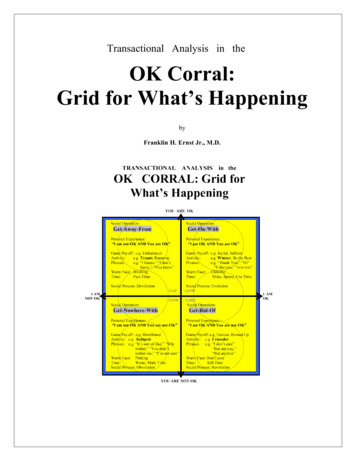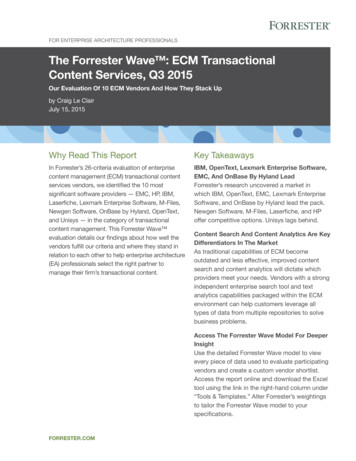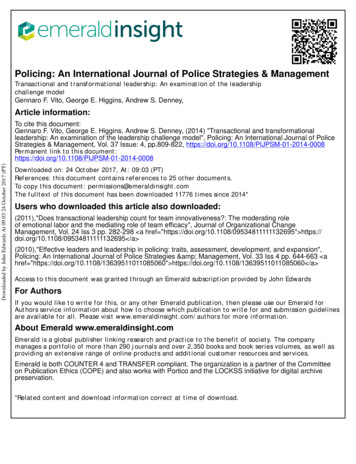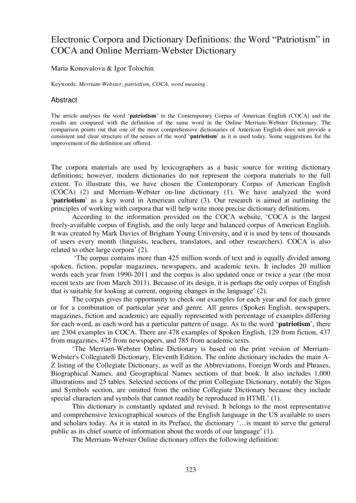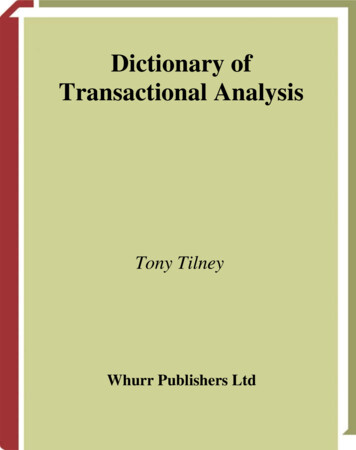
Transcription
Dictionary ofTransactional AnalysisTony TilneyWhurr Publishers Ltd
Dictionary ofTransactionalAnalysis
This page intentionally left blank
Dictionary ofTransactionalAnalysisTony TilneyThanet Centre for Psychotherapeutic StudiesBirminghamConsulting Editor: Professor Windy DrydenGoldsmiths College, University of LondonWWhurr Publishers LtdLondon
1998 Whurr PublishersFirst published 1998 byWhurr Publishers Ltd19b Compton Terrace, London N1 2UN, EnglandReprinted 1999 and 2001All rights reserved. No part of this publication may bereproduced, stored in a retrieval system, or transmitted in any form or by any means, electronic, mechanical, photocopying, recording or otherwise, withoutthe prior permission of Whurr Publishers Limited.This publication is sold subject to the conditions thatit shall not, by way of trade or otherwise, be lent,resold, hired out, or otherwise circulated without thepublisher’s prior consent in any form of binding orcover other than that in which it is published andwithout a similar condition including this conditionbeing imposed upon any subsequent purchaser.British Library Cataloguing-in-Publication DataA catalogue record for this book is available from theBritish Library.ISBN: 1 86156 022 2Printed and bound in the UK by Publish on DemandLtd, London
ContentsAcknowledgementsviIntroductionviiThe dictionary1Appendix 1: reading list137Appendix 2: winners of the Eric Berne Memorial Award139Appendix 3: codes of ethics142References147v
AcknowledgementsI should like to thank Adrienne Lee for giving me access to previously unpublishedmaterial and pre-publication access to her chapter on process in Contracts inCounselling (Lee, 1997), Ian Stewart for giving me pre-publication access to his chapter on the history of transactional analysis in Developments in Psychotherapy,Historical Perspectives (Stewart, 1996a), Mairi Evans and Andy Fookes for the entry onGestalt therapy, Andy Fookes for the entry on person-centred therapy, Paul Richardsfor the entry on NLP and to Ann Smith for her ideas on the ‘drowning person’ diagram. I am also grateful to Mairi Evans for constructive criticism and helpful advice.My thanks also go to Chris Davidson who did an outstanding job in creating the diagrams.I am grateful to the copyright holders for permission to reproduce the following material which forms part of this book.The Institute of Transactional Analysis, the European Association for TransactionalAnalysis and the International Transactional Analysis Association for the use of their codesof ethics.From the Transactional Analysis Journal (TAJ) and the Transactional Analysis Bulletin(TAB).John Dusay for the Egogram: TAJ (1972) 2:3.Franklin Ernst for the OK corral. TAJ (1971) 1:4.Richard Erskine and Marilyn Zalcman for the Racket System: TAJ (1979) 9:1.Taibi Kahler PhD for the Miniscript: TAJ (1974) 4:1.Stephen Karpman for the Drama Triangle: TAB (1968) 7:26.Ken Mellor for Impasses: a developmental and structural understanding: TAJ (1980)10:3.Ken Mellor and Eric Sigmund for the Discount Matrix: TAJ (1975) 5:3.vi
IntroductionUnderstanding what transactional analysis is aboutTo understand transactional analysis it is essential to know something of its history.Eric Berne, its founder, after qualifying as a psychiatrist, decided to train in psychoanalysis. This approach concentrates on intrapsychic (within the mind) changes andgives little weight to interactions between people.Psychoanalysis, like many other psychotherapeutic approaches, is essentially a oneperson psychology. In his work as a psychiatrist, Berne became increasingly interested inthe interpersonal dimension. Harry Stack Sullivan (1953) had started to look at this from aposition somewhat outside the mainstream of psychoanalysis. Berne’s original objectivewas to extend psychoanalysis into the interpersonal field and he published a series ofpapers on this topic in professional journals. As he developed his ideas they met increasing resistance from psychoanalysts. He eventually decided to terminate his training in psychoanalysis and establish a new school, which he called transactional analysis (he hadalready chosen the term transaction for the unit of interpersonal interaction). This addedthe analysis of interpersonal interactions to the analysis of intrapsychic processes andintegrated the two viewpoints – people’s private experiences and how they behavedtowards each other – to create a two-person psychology. He thus brought together theinsights of the psychoanalysts with the objectivity of the behaviourists. He developednew theory, in particular concerning ego-states, which made this integration possible. Headded a third element, his personal philosophical position rooted in humanistic values.He sought to value and empower his patients (a central principle of transactional analysisis that everyone can think and make decisions for themselves) and so set up relations withthem that were open, respectful and authentic. To this end he set out to turn theory into ashared resource that can be used by both client and therapist. This involved clarifying,demystifying and finding simple ways of representing key elements.He set out his theories in a brilliant book Transactional Analysis in Psychotherapy(Berne, 1961) which had little immediate impact. He then wrote a book on one aspect ofhis ideas, games theory. Games People Play (Berne, 1964) became a worldwide bestseller and transactional analysis had a meteoric start unique in psychotherapy. This earlysuccess brought both fame and misunderstanding as this book contains only a brief outline of transactional analysis theory. Games People Play remains the book by which Berneand transactional analysis are best known but games theory developed rapidly after itspublication and much of this book is now seriously out of date.vii
IntroductionUsing this dictionaryWords printed in capitals indicate that more information can be obtained by lookingunder that heading in the dictionary. Note that the dictionary entry may not be identical with the capitalised word, as the latter has to conform to the grammatical requirements of the sentence in which it occurs (for example, you will find information onTRANSACTING under transactions).If you have had little previous contact with transactional analysis you will find it helpful to look first at the following entries:Berne, Ericego-statestransactionsgamesscriptmethodology of transactional analysislanguage of transactional analysistheoretical stance of transactional analysisphilosophy of transactional analysishistory of transactional analysismessage formatschools of transactional analysisliterature of transactional analysisDictionaries are usually thought of as providing definitions. A technical dictionarylike this also needs to provide explanations. These are not always the same thing. Anexplanation is designed to build understanding. A definition sets boundaries to theterm so that a decision can be made as to what does and what does not fall into thecategory. A definition does not become meaningful until the explanation has beenunderstood. Sometimes both functions can be held in one process; a clear explanationclarifies boundaries, a good definition conveys the essence of the idea. Sometimes thetasks of explaining and defining have to be addressed separately. I hope I have kept aproper balance between the two.Transactional analysis presents unique problems in selecting words to include in a dictionary. These problems derive from its unusual history. Transactional analysis grew outof psychoanalysis, in which Eric Berne trained. He and the other founders set out to eliminate any terms that were unessential and to find, wherever possible, specifiable behaviours that could be linked to the terms. There was therefore a major shift in the directionof behavioural definitions; for example, the term transference almost disappeared butmany behaviour patterns that involved transference were named (such as games, scripts,rackets, drivers, rubberbanding, complementary transactions). The theory thus becameless abstract and more accessible and ‘user friendly’. At the same time TA expanded in anumber of fields: education, organisations, self-help groups, counselling and psychotherapy. Its concrete and straightforward style made it successful in the first three. However, in psychotherapy it sought to establish itself as a depth psychology and increase therange of psychological conditions it was prepared to address. As this occurred it founditself increasingly cramped by the discarding of intrapsychic language. Two approacheswere adopted to address this problem: an elaboration of transactional analysis theory tofill the gap and borrowing from psychoanalysis. The latter has become increasingly important, particularly drawing on those areas of psychoanalysis that had expanded or originatviii
Introductioned after TA split off in the 1960s, namely object relations and self psychology. A significantpoint was when Carlo Moiso was given the Eric Berne Memorial Scientific Award in 1987for his article on Ego-states and transference (Moiso, 1985), integrating TA and psychoanalytic concepts. This was followed by an increasing number of articles written from anintegrative standpoint (such as Clark, 1991). There was another obvious change: before1985 TA tended to look inwards and articles were almost exclusively referenced to otherTA articles. Now, looking through the Transactional Analysis Journal, many of the references are to sources outside TA. Ian Stewart (1996a) has called this process ‘the psychoanalytic renaissance’. It has sometimes generated tensions among transactional analysts,some of whom fear that TA may lose its crispness and objectivity if it veers too far towardspsychoanalysis, whereas others believe that too close an adherence to past patterns mayimpede growth. A dictionary of TA must reflect the field as a whole. I have thereforeincluded the major concepts of TA but have also provided resources needed to read a contemporary advanced article by one of the major integrative writers such as Richard Erskine. This involved including a substantial number of non-TA words. The criterion I haveused for selecting these words is to include: Words used by Eric Berne (who trained as a psychoanalyst) and which are thereforeessential to understanding the core literature of TA. An example is ego-dystonic. Words borrowed by transactional analysts and in widespread use – and thereforeessential if the dictionary is to enable a reader to make sense of the current literaturee.g. Gestalt, attachment, holding, containment. Words from other disciplines relating to ideas that have been, or are being, integratedinto transactional analysis (e.g. depressive position, projective identification). Thenon-TA origin of all these words is clearly indicated.Writing this dictionary focused my attention on how problematic is the function ofwords in conveying meaning. The setting out of a word suggests that there is a precisemeaning that can be conveyed to the reader, but the ultimate source of all meaning isexperience (including experience of other meaning structures) and the reader may lackthis. As Wilfred Bion, the object relations theorist, pointed out, a function of terminologyis to create spaces into which meaning may enter. He wrote: ‘the advantage of employing asign . is that it at least indicates that the reader’s comprehension of my meaning shouldcontain an element that will remain unsatisfied until he meets the appropriate realisation.’For example, a dictionary may contain a definition of the word ‘elephant’. However goodthis is, it can give little idea of what the experience of seeing an elephant would be like.However, the definition is good enough if, after reading it, anyone seeing an elephant forthe first time thinks immediately ‘that must be an elephant’. It is a tempting for the dictionary-maker to labour overmuch at defining elephants. I hope I have avoided this.ix
This page intentionally left blank
AA Layman’s Guide to Psychiatry andPsychoanalysis Eric Berne’s firstbook, originally published under thetitle THE MIND IN ACTION in 1947 and sopredating the emergence of transactional analysis as a separate discipline.This looked mainly at classical (DRIVETHEORY) PSYCHOANALYSIS but is enlivenedby Berne’s lucid, friendly and humorous style. Revised editions incorporating some transactional analysis werepublished under the title TheLayman’s Guide to Psychiatry andPsychoanalysis in 1957 and 1967, thelatter edition also incorporating contributions from other transactionalanalysts.abreaction a release of emotion occurring (usually) in the course of therapyor counselling as a result of contacting Child ego-state experiences.accreditation recognition by a professional organisation. For transactionalanalysts in the UK this body is theInstitute of Transactional Analysis( ITA ), which is affiliated to theEuropean Association for TransactionalAnalysis (EATA). Accredited transactional analysts are known as certifiedtransactionalanalysts( CTA ).Certification may be obtained in different specialities (clinical, organisational,educational, counselling). Certifiedtransactional analysts in the UK mayapply for professional membership ofthe Institute of Transactional Analysis.As the ITA is a member organisationof the United Kingdom Council forPsychotherapy (the major governingbody for psychotherapy in the UK),transactional analysts with clinical speciality become UKCP registered psychotherapists. Most national andregional transactional analysis associations are linked by a system of agreements with the International Transactional Analysis Association ( ITAA )and as a result there is mutual recognition of qualifications worldwide.acting out expressing unresolved psychological issues through behaviour.This brings some relief from psychological pain by providing a channel forrepressed feelings but maintains t
Transactional analysis presents unique problems in selecting words to include in a dic-tionary. These problems derive from its unusual history. Transactional analysis grew out of psychoanalysis, in which Eric Berne trained. He and the other founders set out to elim-inate any terms that were unessential and to find, wherever possible, specifiable behav- iours that could be linked to the terms .
